Investigation of Vacation Report Factors and Overall Satisfaction for a Resort
VerifiedAdded on 2023/06/04
|13
|4101
|246
AI Summary
The report investigates the satisfaction factors to resort and the overall customer satisfaction based on the feedback of the regular customers of the resort. Correlation and regression analysis have been done. The results have been obtained using SPSS. The results have been displayed as well.
Contribute Materials
Your contribution can guide someone’s learning journey. Share your
documents today.
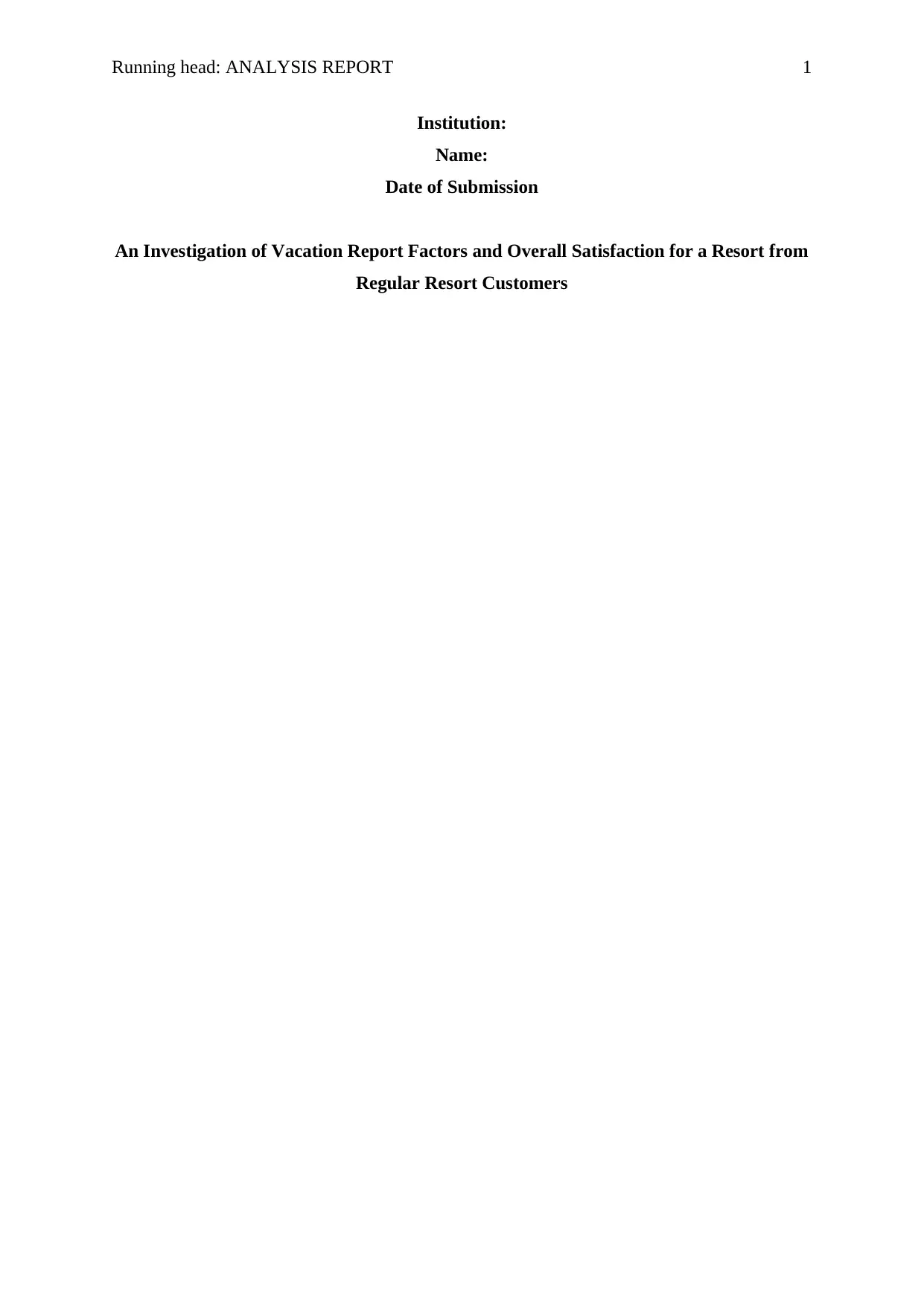
Running head: ANALYSIS REPORT 1
Institution:
Name:
Date of Submission
An Investigation of Vacation Report Factors and Overall Satisfaction for a Resort from
Regular Resort Customers
Institution:
Name:
Date of Submission
An Investigation of Vacation Report Factors and Overall Satisfaction for a Resort from
Regular Resort Customers
Secure Best Marks with AI Grader
Need help grading? Try our AI Grader for instant feedback on your assignments.
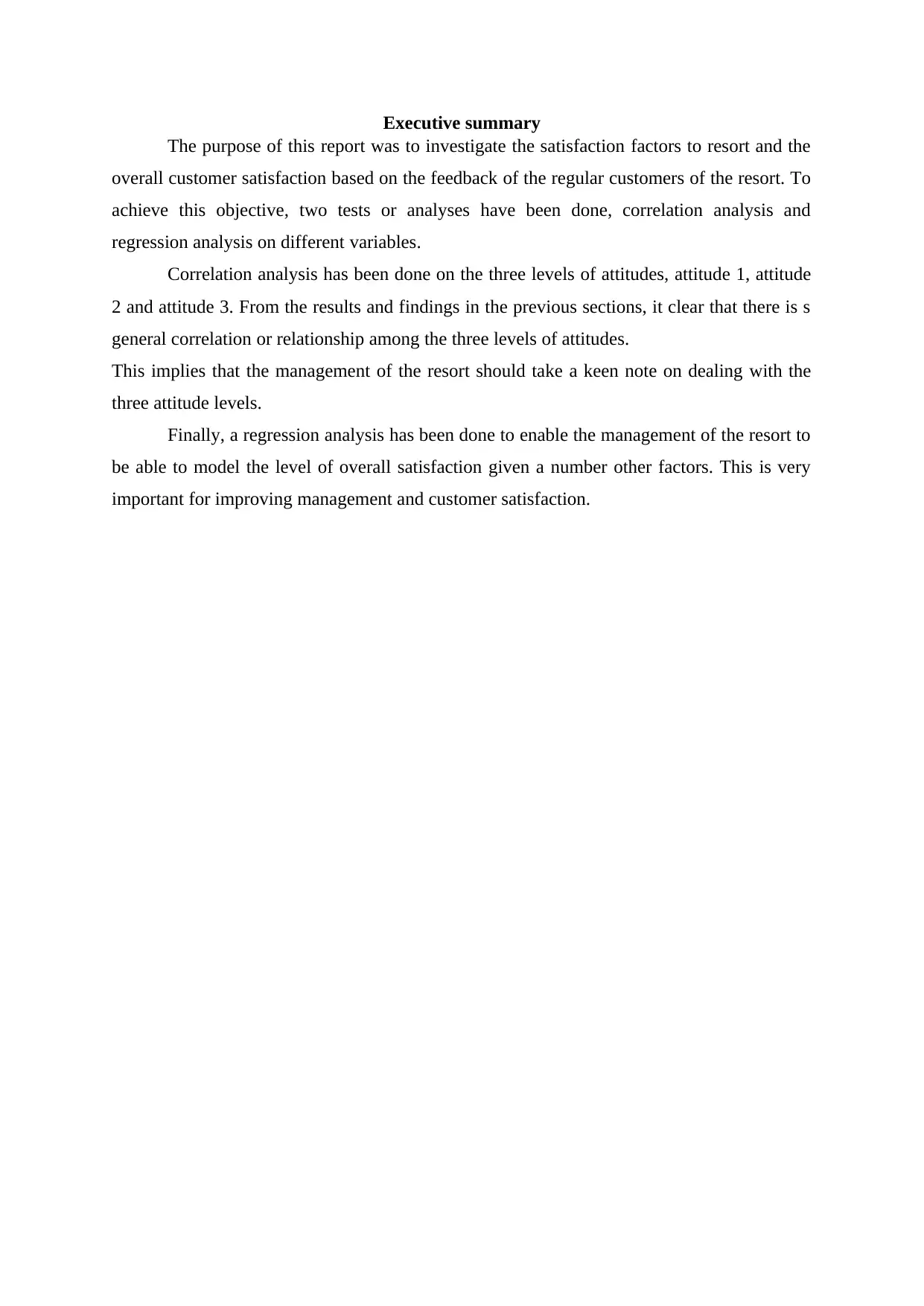
Executive summary
The purpose of this report was to investigate the satisfaction factors to resort and the
overall customer satisfaction based on the feedback of the regular customers of the resort. To
achieve this objective, two tests or analyses have been done, correlation analysis and
regression analysis on different variables.
Correlation analysis has been done on the three levels of attitudes, attitude 1, attitude
2 and attitude 3. From the results and findings in the previous sections, it clear that there is s
general correlation or relationship among the three levels of attitudes.
This implies that the management of the resort should take a keen note on dealing with the
three attitude levels.
Finally, a regression analysis has been done to enable the management of the resort to
be able to model the level of overall satisfaction given a number other factors. This is very
important for improving management and customer satisfaction.
The purpose of this report was to investigate the satisfaction factors to resort and the
overall customer satisfaction based on the feedback of the regular customers of the resort. To
achieve this objective, two tests or analyses have been done, correlation analysis and
regression analysis on different variables.
Correlation analysis has been done on the three levels of attitudes, attitude 1, attitude
2 and attitude 3. From the results and findings in the previous sections, it clear that there is s
general correlation or relationship among the three levels of attitudes.
This implies that the management of the resort should take a keen note on dealing with the
three attitude levels.
Finally, a regression analysis has been done to enable the management of the resort to
be able to model the level of overall satisfaction given a number other factors. This is very
important for improving management and customer satisfaction.
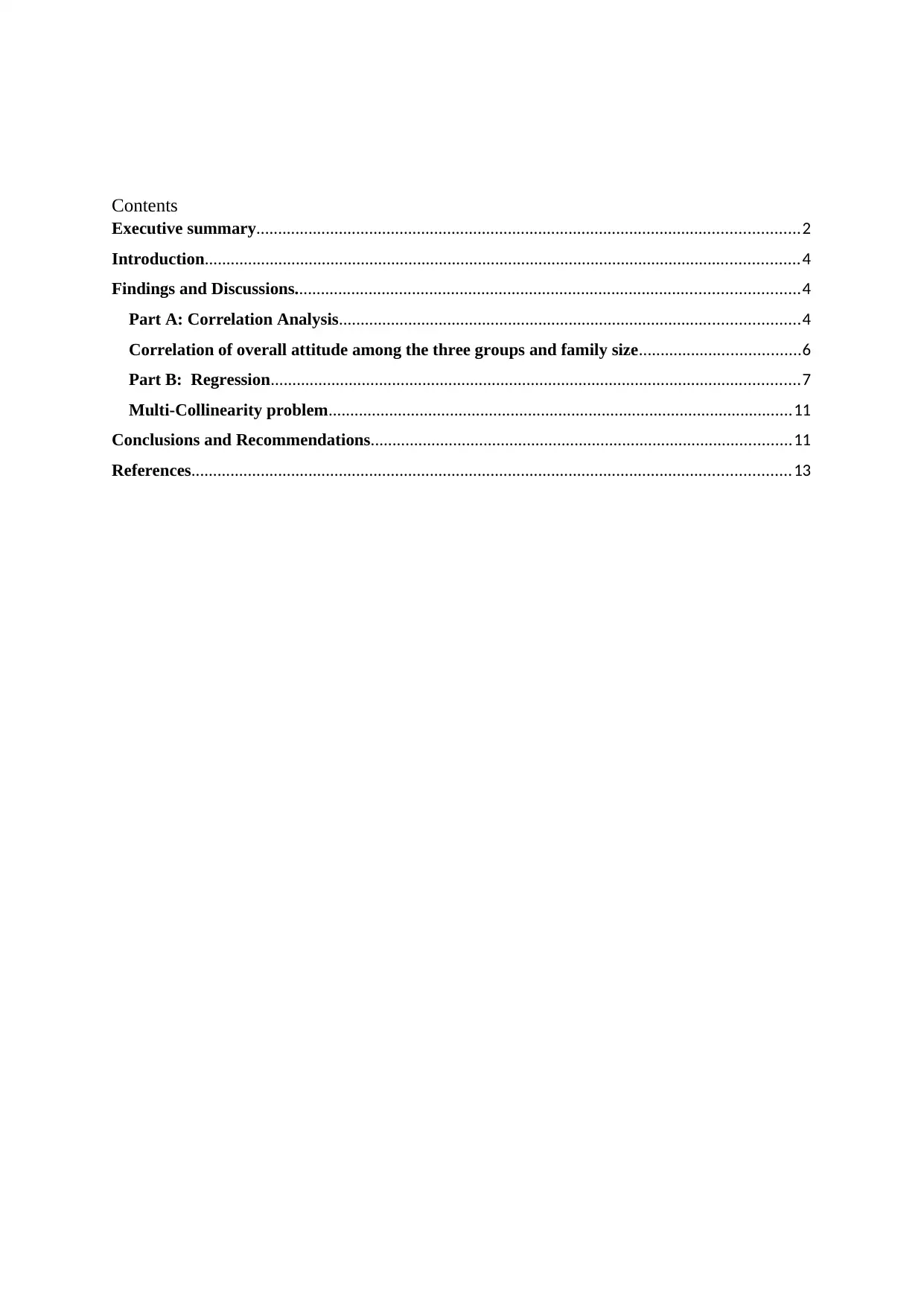
Contents
Executive summary.............................................................................................................................2
Introduction.........................................................................................................................................4
Findings and Discussions....................................................................................................................4
Part A: Correlation Analysis..........................................................................................................4
Correlation of overall attitude among the three groups and family size.....................................6
Part B: Regression..........................................................................................................................7
Multi-Collinearity problem...........................................................................................................11
Conclusions and Recommendations.................................................................................................11
References..........................................................................................................................................13
Executive summary.............................................................................................................................2
Introduction.........................................................................................................................................4
Findings and Discussions....................................................................................................................4
Part A: Correlation Analysis..........................................................................................................4
Correlation of overall attitude among the three groups and family size.....................................6
Part B: Regression..........................................................................................................................7
Multi-Collinearity problem...........................................................................................................11
Conclusions and Recommendations.................................................................................................11
References..........................................................................................................................................13
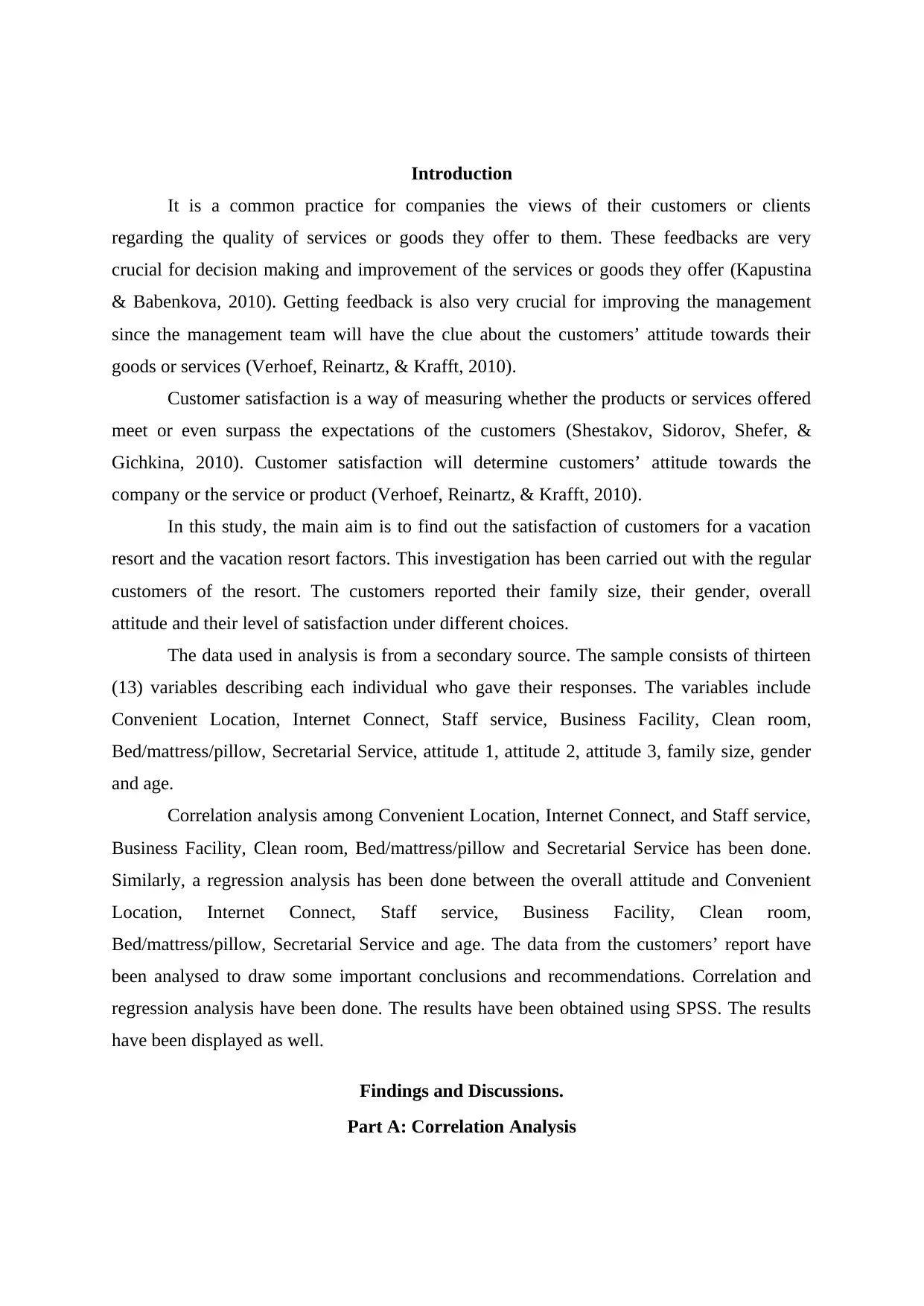
Introduction
It is a common practice for companies the views of their customers or clients
regarding the quality of services or goods they offer to them. These feedbacks are very
crucial for decision making and improvement of the services or goods they offer (Kapustina
& Babenkova, 2010). Getting feedback is also very crucial for improving the management
since the management team will have the clue about the customers’ attitude towards their
goods or services (Verhoef, Reinartz, & Krafft, 2010).
Customer satisfaction is a way of measuring whether the products or services offered
meet or even surpass the expectations of the customers (Shestakov, Sidorov, Shefer, &
Gichkina, 2010). Customer satisfaction will determine customers’ attitude towards the
company or the service or product (Verhoef, Reinartz, & Krafft, 2010).
In this study, the main aim is to find out the satisfaction of customers for a vacation
resort and the vacation resort factors. This investigation has been carried out with the regular
customers of the resort. The customers reported their family size, their gender, overall
attitude and their level of satisfaction under different choices.
The data used in analysis is from a secondary source. The sample consists of thirteen
(13) variables describing each individual who gave their responses. The variables include
Convenient Location, Internet Connect, Staff service, Business Facility, Clean room,
Bed/mattress/pillow, Secretarial Service, attitude 1, attitude 2, attitude 3, family size, gender
and age.
Correlation analysis among Convenient Location, Internet Connect, and Staff service,
Business Facility, Clean room, Bed/mattress/pillow and Secretarial Service has been done.
Similarly, a regression analysis has been done between the overall attitude and Convenient
Location, Internet Connect, Staff service, Business Facility, Clean room,
Bed/mattress/pillow, Secretarial Service and age. The data from the customers’ report have
been analysed to draw some important conclusions and recommendations. Correlation and
regression analysis have been done. The results have been obtained using SPSS. The results
have been displayed as well.
Findings and Discussions.
Part A: Correlation Analysis
It is a common practice for companies the views of their customers or clients
regarding the quality of services or goods they offer to them. These feedbacks are very
crucial for decision making and improvement of the services or goods they offer (Kapustina
& Babenkova, 2010). Getting feedback is also very crucial for improving the management
since the management team will have the clue about the customers’ attitude towards their
goods or services (Verhoef, Reinartz, & Krafft, 2010).
Customer satisfaction is a way of measuring whether the products or services offered
meet or even surpass the expectations of the customers (Shestakov, Sidorov, Shefer, &
Gichkina, 2010). Customer satisfaction will determine customers’ attitude towards the
company or the service or product (Verhoef, Reinartz, & Krafft, 2010).
In this study, the main aim is to find out the satisfaction of customers for a vacation
resort and the vacation resort factors. This investigation has been carried out with the regular
customers of the resort. The customers reported their family size, their gender, overall
attitude and their level of satisfaction under different choices.
The data used in analysis is from a secondary source. The sample consists of thirteen
(13) variables describing each individual who gave their responses. The variables include
Convenient Location, Internet Connect, Staff service, Business Facility, Clean room,
Bed/mattress/pillow, Secretarial Service, attitude 1, attitude 2, attitude 3, family size, gender
and age.
Correlation analysis among Convenient Location, Internet Connect, and Staff service,
Business Facility, Clean room, Bed/mattress/pillow and Secretarial Service has been done.
Similarly, a regression analysis has been done between the overall attitude and Convenient
Location, Internet Connect, Staff service, Business Facility, Clean room,
Bed/mattress/pillow, Secretarial Service and age. The data from the customers’ report have
been analysed to draw some important conclusions and recommendations. Correlation and
regression analysis have been done. The results have been obtained using SPSS. The results
have been displayed as well.
Findings and Discussions.
Part A: Correlation Analysis
Secure Best Marks with AI Grader
Need help grading? Try our AI Grader for instant feedback on your assignments.
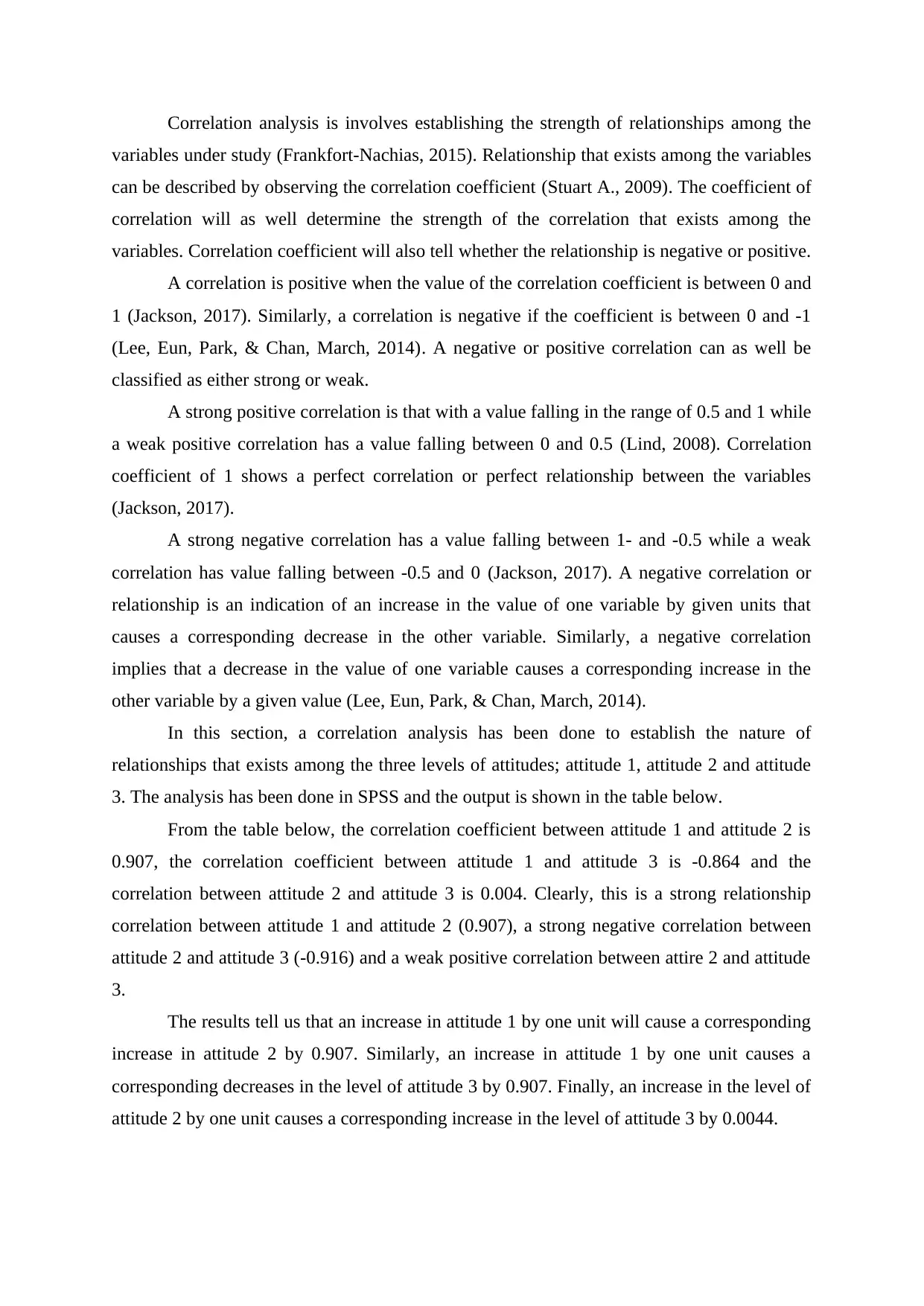
Correlation analysis is involves establishing the strength of relationships among the
variables under study (Frankfort-Nachias, 2015). Relationship that exists among the variables
can be described by observing the correlation coefficient (Stuart A., 2009). The coefficient of
correlation will as well determine the strength of the correlation that exists among the
variables. Correlation coefficient will also tell whether the relationship is negative or positive.
A correlation is positive when the value of the correlation coefficient is between 0 and
1 (Jackson, 2017). Similarly, a correlation is negative if the coefficient is between 0 and -1
(Lee, Eun, Park, & Chan, March, 2014). A negative or positive correlation can as well be
classified as either strong or weak.
A strong positive correlation is that with a value falling in the range of 0.5 and 1 while
a weak positive correlation has a value falling between 0 and 0.5 (Lind, 2008). Correlation
coefficient of 1 shows a perfect correlation or perfect relationship between the variables
(Jackson, 2017).
A strong negative correlation has a value falling between 1- and -0.5 while a weak
correlation has value falling between -0.5 and 0 (Jackson, 2017). A negative correlation or
relationship is an indication of an increase in the value of one variable by given units that
causes a corresponding decrease in the other variable. Similarly, a negative correlation
implies that a decrease in the value of one variable causes a corresponding increase in the
other variable by a given value (Lee, Eun, Park, & Chan, March, 2014).
In this section, a correlation analysis has been done to establish the nature of
relationships that exists among the three levels of attitudes; attitude 1, attitude 2 and attitude
3. The analysis has been done in SPSS and the output is shown in the table below.
From the table below, the correlation coefficient between attitude 1 and attitude 2 is
0.907, the correlation coefficient between attitude 1 and attitude 3 is -0.864 and the
correlation between attitude 2 and attitude 3 is 0.004. Clearly, this is a strong relationship
correlation between attitude 1 and attitude 2 (0.907), a strong negative correlation between
attitude 2 and attitude 3 (-0.916) and a weak positive correlation between attire 2 and attitude
3.
The results tell us that an increase in attitude 1 by one unit will cause a corresponding
increase in attitude 2 by 0.907. Similarly, an increase in attitude 1 by one unit causes a
corresponding decreases in the level of attitude 3 by 0.907. Finally, an increase in the level of
attitude 2 by one unit causes a corresponding increase in the level of attitude 3 by 0.0044.
variables under study (Frankfort-Nachias, 2015). Relationship that exists among the variables
can be described by observing the correlation coefficient (Stuart A., 2009). The coefficient of
correlation will as well determine the strength of the correlation that exists among the
variables. Correlation coefficient will also tell whether the relationship is negative or positive.
A correlation is positive when the value of the correlation coefficient is between 0 and
1 (Jackson, 2017). Similarly, a correlation is negative if the coefficient is between 0 and -1
(Lee, Eun, Park, & Chan, March, 2014). A negative or positive correlation can as well be
classified as either strong or weak.
A strong positive correlation is that with a value falling in the range of 0.5 and 1 while
a weak positive correlation has a value falling between 0 and 0.5 (Lind, 2008). Correlation
coefficient of 1 shows a perfect correlation or perfect relationship between the variables
(Jackson, 2017).
A strong negative correlation has a value falling between 1- and -0.5 while a weak
correlation has value falling between -0.5 and 0 (Jackson, 2017). A negative correlation or
relationship is an indication of an increase in the value of one variable by given units that
causes a corresponding decrease in the other variable. Similarly, a negative correlation
implies that a decrease in the value of one variable causes a corresponding increase in the
other variable by a given value (Lee, Eun, Park, & Chan, March, 2014).
In this section, a correlation analysis has been done to establish the nature of
relationships that exists among the three levels of attitudes; attitude 1, attitude 2 and attitude
3. The analysis has been done in SPSS and the output is shown in the table below.
From the table below, the correlation coefficient between attitude 1 and attitude 2 is
0.907, the correlation coefficient between attitude 1 and attitude 3 is -0.864 and the
correlation between attitude 2 and attitude 3 is 0.004. Clearly, this is a strong relationship
correlation between attitude 1 and attitude 2 (0.907), a strong negative correlation between
attitude 2 and attitude 3 (-0.916) and a weak positive correlation between attire 2 and attitude
3.
The results tell us that an increase in attitude 1 by one unit will cause a corresponding
increase in attitude 2 by 0.907. Similarly, an increase in attitude 1 by one unit causes a
corresponding decreases in the level of attitude 3 by 0.907. Finally, an increase in the level of
attitude 2 by one unit causes a corresponding increase in the level of attitude 3 by 0.0044.
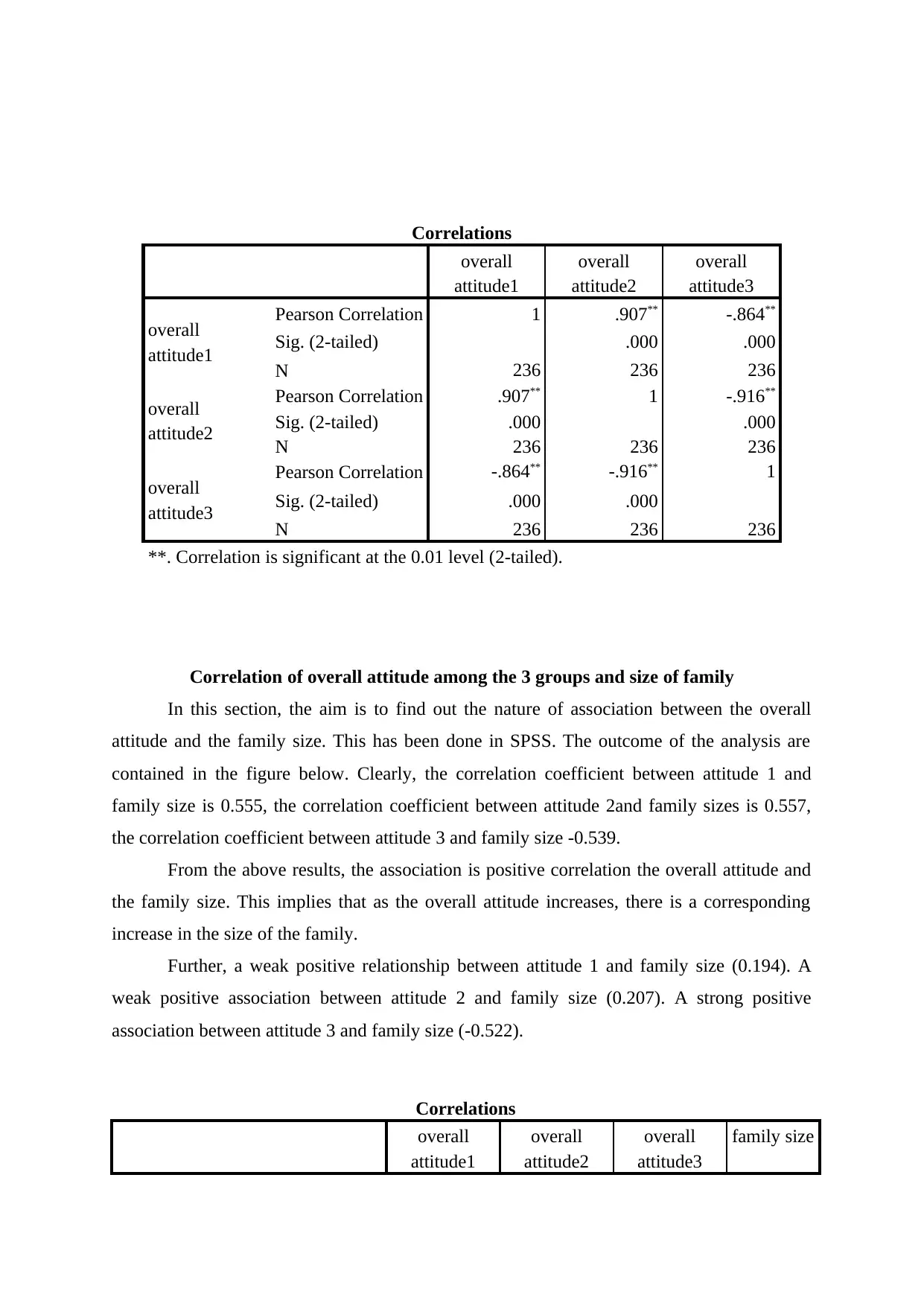
Correlations
overall
attitude1
overall
attitude2
overall
attitude3
overall
attitude1
Pearson Correlation 1 .907** -.864**
Sig. (2-tailed) .000 .000
N 236 236 236
overall
attitude2
Pearson Correlation .907** 1 -.916**
Sig. (2-tailed) .000 .000
N 236 236 236
overall
attitude3
Pearson Correlation -.864** -.916** 1
Sig. (2-tailed) .000 .000
N 236 236 236
**. Correlation is significant at the 0.01 level (2-tailed).
Correlation of overall attitude among the 3 groups and size of family
In this section, the aim is to find out the nature of association between the overall
attitude and the family size. This has been done in SPSS. The outcome of the analysis are
contained in the figure below. Clearly, the correlation coefficient between attitude 1 and
family size is 0.555, the correlation coefficient between attitude 2and family sizes is 0.557,
the correlation coefficient between attitude 3 and family size -0.539.
From the above results, the association is positive correlation the overall attitude and
the family size. This implies that as the overall attitude increases, there is a corresponding
increase in the size of the family.
Further, a weak positive relationship between attitude 1 and family size (0.194). A
weak positive association between attitude 2 and family size (0.207). A strong positive
association between attitude 3 and family size (-0.522).
Correlations
overall
attitude1
overall
attitude2
overall
attitude3
family size
overall
attitude1
overall
attitude2
overall
attitude3
overall
attitude1
Pearson Correlation 1 .907** -.864**
Sig. (2-tailed) .000 .000
N 236 236 236
overall
attitude2
Pearson Correlation .907** 1 -.916**
Sig. (2-tailed) .000 .000
N 236 236 236
overall
attitude3
Pearson Correlation -.864** -.916** 1
Sig. (2-tailed) .000 .000
N 236 236 236
**. Correlation is significant at the 0.01 level (2-tailed).
Correlation of overall attitude among the 3 groups and size of family
In this section, the aim is to find out the nature of association between the overall
attitude and the family size. This has been done in SPSS. The outcome of the analysis are
contained in the figure below. Clearly, the correlation coefficient between attitude 1 and
family size is 0.555, the correlation coefficient between attitude 2and family sizes is 0.557,
the correlation coefficient between attitude 3 and family size -0.539.
From the above results, the association is positive correlation the overall attitude and
the family size. This implies that as the overall attitude increases, there is a corresponding
increase in the size of the family.
Further, a weak positive relationship between attitude 1 and family size (0.194). A
weak positive association between attitude 2 and family size (0.207). A strong positive
association between attitude 3 and family size (-0.522).
Correlations
overall
attitude1
overall
attitude2
overall
attitude3
family size
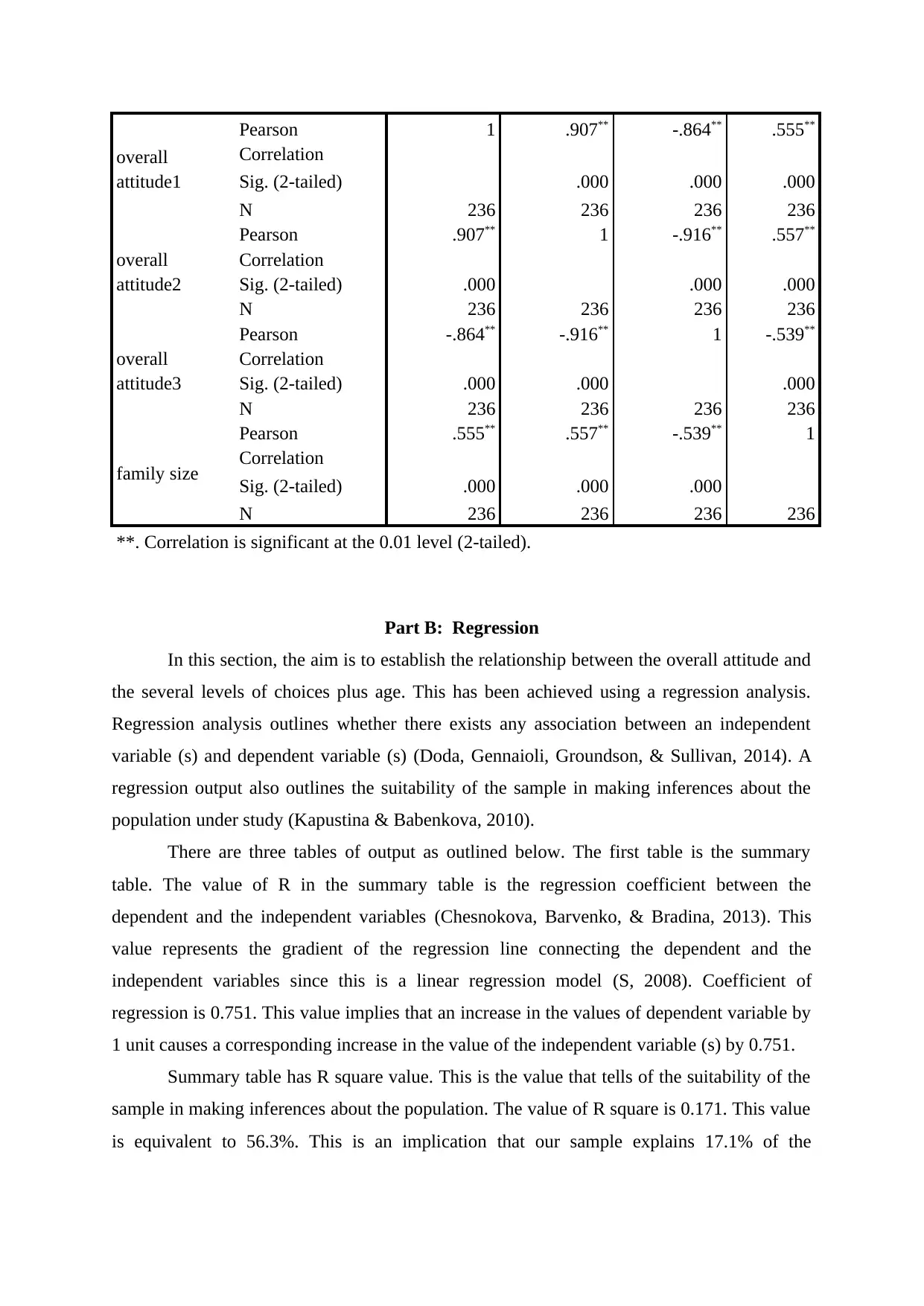
overall
attitude1
Pearson
Correlation
1 .907** -.864** .555**
Sig. (2-tailed) .000 .000 .000
N 236 236 236 236
overall
attitude2
Pearson
Correlation
.907** 1 -.916** .557**
Sig. (2-tailed) .000 .000 .000
N 236 236 236 236
overall
attitude3
Pearson
Correlation
-.864** -.916** 1 -.539**
Sig. (2-tailed) .000 .000 .000
N 236 236 236 236
family size
Pearson
Correlation
.555** .557** -.539** 1
Sig. (2-tailed) .000 .000 .000
N 236 236 236 236
**. Correlation is significant at the 0.01 level (2-tailed).
Part B: Regression
In this section, the aim is to establish the relationship between the overall attitude and
the several levels of choices plus age. This has been achieved using a regression analysis.
Regression analysis outlines whether there exists any association between an independent
variable (s) and dependent variable (s) (Doda, Gennaioli, Groundson, & Sullivan, 2014). A
regression output also outlines the suitability of the sample in making inferences about the
population under study (Kapustina & Babenkova, 2010).
There are three tables of output as outlined below. The first table is the summary
table. The value of R in the summary table is the regression coefficient between the
dependent and the independent variables (Chesnokova, Barvenko, & Bradina, 2013). This
value represents the gradient of the regression line connecting the dependent and the
independent variables since this is a linear regression model (S, 2008). Coefficient of
regression is 0.751. This value implies that an increase in the values of dependent variable by
1 unit causes a corresponding increase in the value of the independent variable (s) by 0.751.
Summary table has R square value. This is the value that tells of the suitability of the
sample in making inferences about the population. The value of R square is 0.171. This value
is equivalent to 56.3%. This is an implication that our sample explains 17.1% of the
attitude1
Pearson
Correlation
1 .907** -.864** .555**
Sig. (2-tailed) .000 .000 .000
N 236 236 236 236
overall
attitude2
Pearson
Correlation
.907** 1 -.916** .557**
Sig. (2-tailed) .000 .000 .000
N 236 236 236 236
overall
attitude3
Pearson
Correlation
-.864** -.916** 1 -.539**
Sig. (2-tailed) .000 .000 .000
N 236 236 236 236
family size
Pearson
Correlation
.555** .557** -.539** 1
Sig. (2-tailed) .000 .000 .000
N 236 236 236 236
**. Correlation is significant at the 0.01 level (2-tailed).
Part B: Regression
In this section, the aim is to establish the relationship between the overall attitude and
the several levels of choices plus age. This has been achieved using a regression analysis.
Regression analysis outlines whether there exists any association between an independent
variable (s) and dependent variable (s) (Doda, Gennaioli, Groundson, & Sullivan, 2014). A
regression output also outlines the suitability of the sample in making inferences about the
population under study (Kapustina & Babenkova, 2010).
There are three tables of output as outlined below. The first table is the summary
table. The value of R in the summary table is the regression coefficient between the
dependent and the independent variables (Chesnokova, Barvenko, & Bradina, 2013). This
value represents the gradient of the regression line connecting the dependent and the
independent variables since this is a linear regression model (S, 2008). Coefficient of
regression is 0.751. This value implies that an increase in the values of dependent variable by
1 unit causes a corresponding increase in the value of the independent variable (s) by 0.751.
Summary table has R square value. This is the value that tells of the suitability of the
sample in making inferences about the population. The value of R square is 0.171. This value
is equivalent to 56.3%. This is an implication that our sample explains 17.1% of the
Paraphrase This Document
Need a fresh take? Get an instant paraphrase of this document with our AI Paraphraser
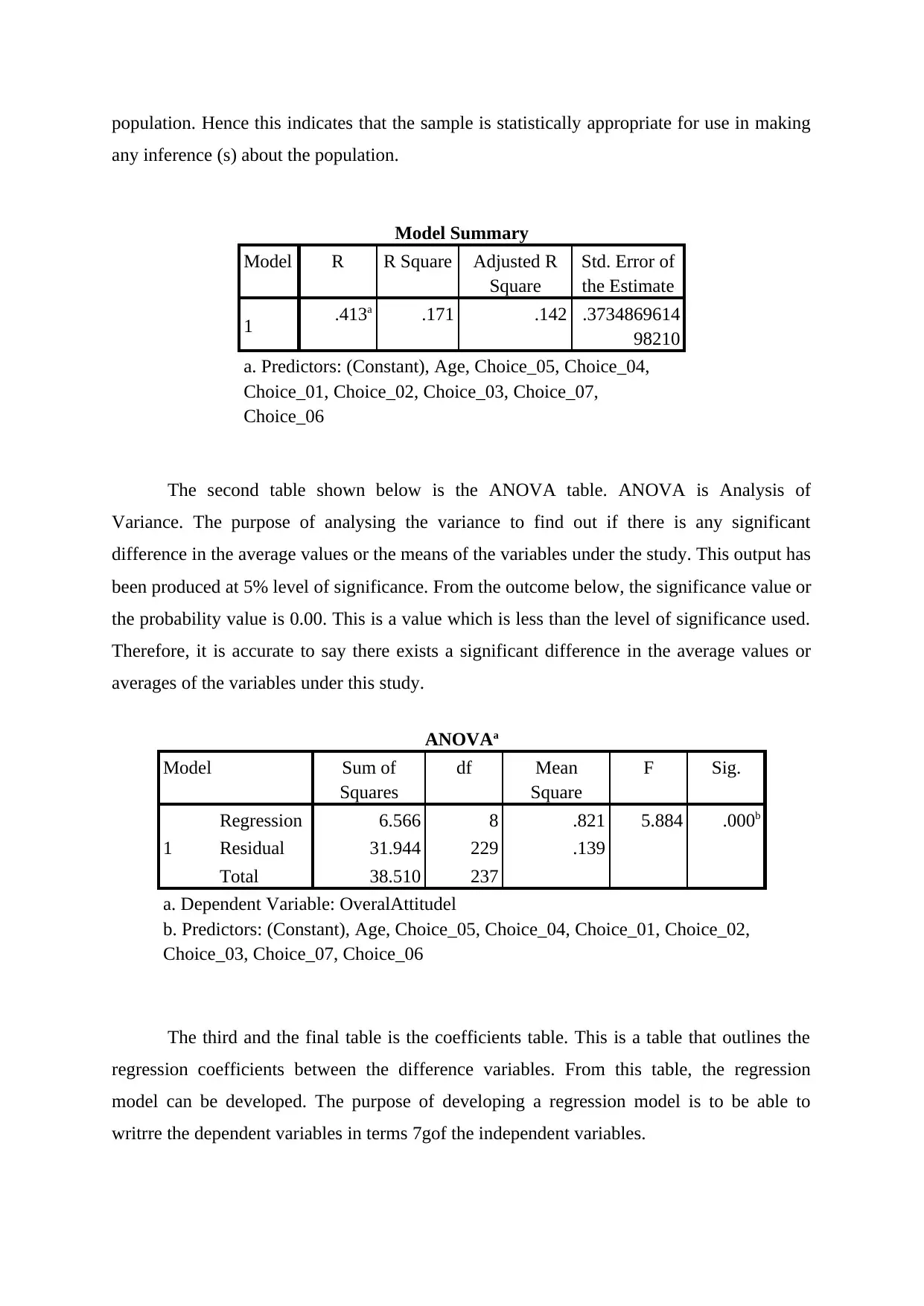
population. Hence this indicates that the sample is statistically appropriate for use in making
any inference (s) about the population.
Model Summary
Model R R Square Adjusted R
Square
Std. Error of
the Estimate
1 .413a .171 .142 .3734869614
98210
a. Predictors: (Constant), Age, Choice_05, Choice_04,
Choice_01, Choice_02, Choice_03, Choice_07,
Choice_06
The second table shown below is the ANOVA table. ANOVA is Analysis of
Variance. The purpose of analysing the variance to find out if there is any significant
difference in the average values or the means of the variables under the study. This output has
been produced at 5% level of significance. From the outcome below, the significance value or
the probability value is 0.00. This is a value which is less than the level of significance used.
Therefore, it is accurate to say there exists a significant difference in the average values or
averages of the variables under this study.
ANOVAa
Model Sum of
Squares
df Mean
Square
F Sig.
1
Regression 6.566 8 .821 5.884 .000b
Residual 31.944 229 .139
Total 38.510 237
a. Dependent Variable: OveralAttitudel
b. Predictors: (Constant), Age, Choice_05, Choice_04, Choice_01, Choice_02,
Choice_03, Choice_07, Choice_06
The third and the final table is the coefficients table. This is a table that outlines the
regression coefficients between the difference variables. From this table, the regression
model can be developed. The purpose of developing a regression model is to be able to
writrre the dependent variables in terms 7gof the independent variables.
any inference (s) about the population.
Model Summary
Model R R Square Adjusted R
Square
Std. Error of
the Estimate
1 .413a .171 .142 .3734869614
98210
a. Predictors: (Constant), Age, Choice_05, Choice_04,
Choice_01, Choice_02, Choice_03, Choice_07,
Choice_06
The second table shown below is the ANOVA table. ANOVA is Analysis of
Variance. The purpose of analysing the variance to find out if there is any significant
difference in the average values or the means of the variables under the study. This output has
been produced at 5% level of significance. From the outcome below, the significance value or
the probability value is 0.00. This is a value which is less than the level of significance used.
Therefore, it is accurate to say there exists a significant difference in the average values or
averages of the variables under this study.
ANOVAa
Model Sum of
Squares
df Mean
Square
F Sig.
1
Regression 6.566 8 .821 5.884 .000b
Residual 31.944 229 .139
Total 38.510 237
a. Dependent Variable: OveralAttitudel
b. Predictors: (Constant), Age, Choice_05, Choice_04, Choice_01, Choice_02,
Choice_03, Choice_07, Choice_06
The third and the final table is the coefficients table. This is a table that outlines the
regression coefficients between the difference variables. From this table, the regression
model can be developed. The purpose of developing a regression model is to be able to
writrre the dependent variables in terms 7gof the independent variables.
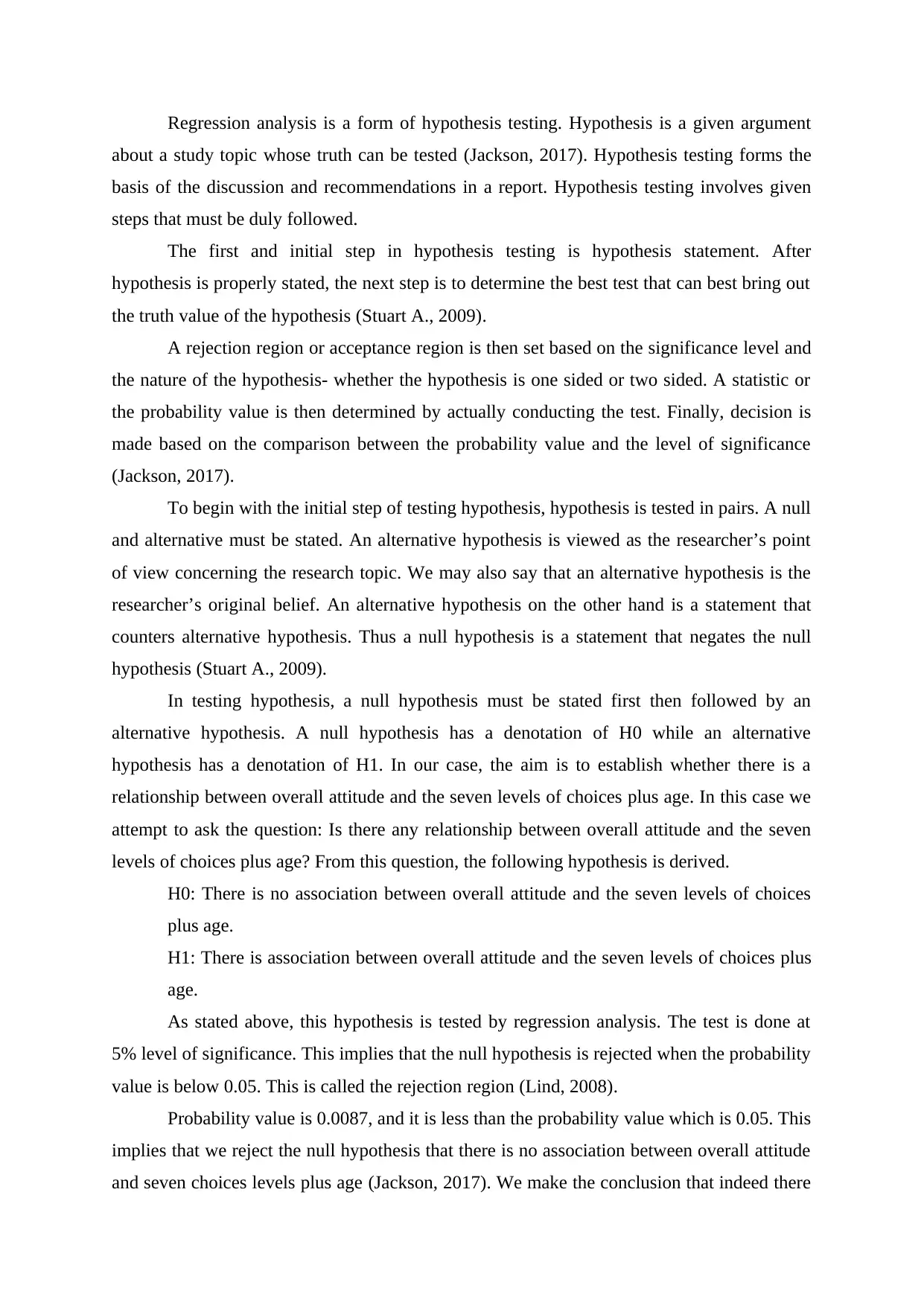
Regression analysis is a form of hypothesis testing. Hypothesis is a given argument
about a study topic whose truth can be tested (Jackson, 2017). Hypothesis testing forms the
basis of the discussion and recommendations in a report. Hypothesis testing involves given
steps that must be duly followed.
The first and initial step in hypothesis testing is hypothesis statement. After
hypothesis is properly stated, the next step is to determine the best test that can best bring out
the truth value of the hypothesis (Stuart A., 2009).
A rejection region or acceptance region is then set based on the significance level and
the nature of the hypothesis- whether the hypothesis is one sided or two sided. A statistic or
the probability value is then determined by actually conducting the test. Finally, decision is
made based on the comparison between the probability value and the level of significance
(Jackson, 2017).
To begin with the initial step of testing hypothesis, hypothesis is tested in pairs. A null
and alternative must be stated. An alternative hypothesis is viewed as the researcher’s point
of view concerning the research topic. We may also say that an alternative hypothesis is the
researcher’s original belief. An alternative hypothesis on the other hand is a statement that
counters alternative hypothesis. Thus a null hypothesis is a statement that negates the null
hypothesis (Stuart A., 2009).
In testing hypothesis, a null hypothesis must be stated first then followed by an
alternative hypothesis. A null hypothesis has a denotation of H0 while an alternative
hypothesis has a denotation of H1. In our case, the aim is to establish whether there is a
relationship between overall attitude and the seven levels of choices plus age. In this case we
attempt to ask the question: Is there any relationship between overall attitude and the seven
levels of choices plus age? From this question, the following hypothesis is derived.
H0: There is no association between overall attitude and the seven levels of choices
plus age.
H1: There is association between overall attitude and the seven levels of choices plus
age.
As stated above, this hypothesis is tested by regression analysis. The test is done at
5% level of significance. This implies that the null hypothesis is rejected when the probability
value is below 0.05. This is called the rejection region (Lind, 2008).
Probability value is 0.0087, and it is less than the probability value which is 0.05. This
implies that we reject the null hypothesis that there is no association between overall attitude
and seven choices levels plus age (Jackson, 2017). We make the conclusion that indeed there
about a study topic whose truth can be tested (Jackson, 2017). Hypothesis testing forms the
basis of the discussion and recommendations in a report. Hypothesis testing involves given
steps that must be duly followed.
The first and initial step in hypothesis testing is hypothesis statement. After
hypothesis is properly stated, the next step is to determine the best test that can best bring out
the truth value of the hypothesis (Stuart A., 2009).
A rejection region or acceptance region is then set based on the significance level and
the nature of the hypothesis- whether the hypothesis is one sided or two sided. A statistic or
the probability value is then determined by actually conducting the test. Finally, decision is
made based on the comparison between the probability value and the level of significance
(Jackson, 2017).
To begin with the initial step of testing hypothesis, hypothesis is tested in pairs. A null
and alternative must be stated. An alternative hypothesis is viewed as the researcher’s point
of view concerning the research topic. We may also say that an alternative hypothesis is the
researcher’s original belief. An alternative hypothesis on the other hand is a statement that
counters alternative hypothesis. Thus a null hypothesis is a statement that negates the null
hypothesis (Stuart A., 2009).
In testing hypothesis, a null hypothesis must be stated first then followed by an
alternative hypothesis. A null hypothesis has a denotation of H0 while an alternative
hypothesis has a denotation of H1. In our case, the aim is to establish whether there is a
relationship between overall attitude and the seven levels of choices plus age. In this case we
attempt to ask the question: Is there any relationship between overall attitude and the seven
levels of choices plus age? From this question, the following hypothesis is derived.
H0: There is no association between overall attitude and the seven levels of choices
plus age.
H1: There is association between overall attitude and the seven levels of choices plus
age.
As stated above, this hypothesis is tested by regression analysis. The test is done at
5% level of significance. This implies that the null hypothesis is rejected when the probability
value is below 0.05. This is called the rejection region (Lind, 2008).
Probability value is 0.0087, and it is less than the probability value which is 0.05. This
implies that we reject the null hypothesis that there is no association between overall attitude
and seven choices levels plus age (Jackson, 2017). We make the conclusion that indeed there
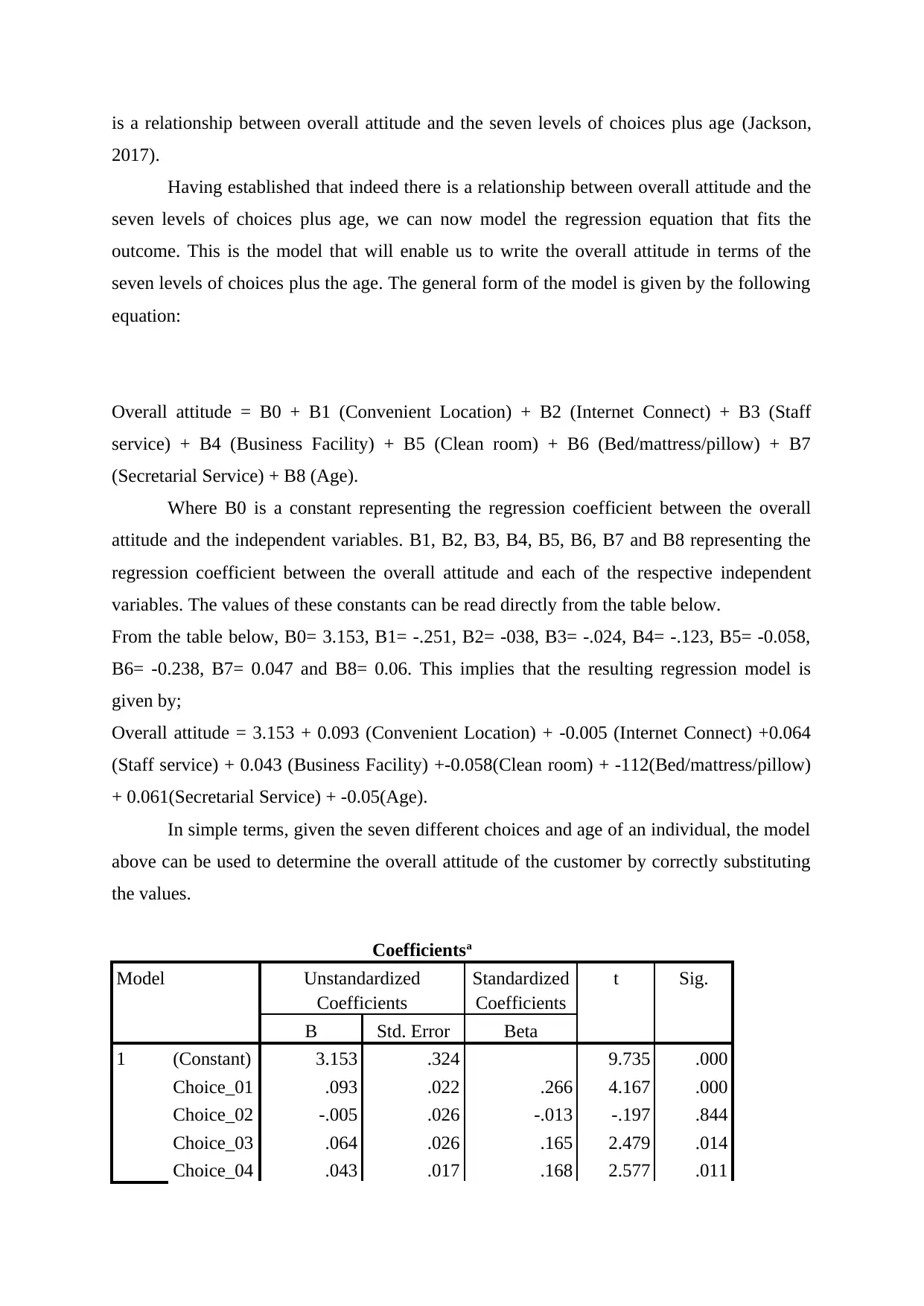
is a relationship between overall attitude and the seven levels of choices plus age (Jackson,
2017).
Having established that indeed there is a relationship between overall attitude and the
seven levels of choices plus age, we can now model the regression equation that fits the
outcome. This is the model that will enable us to write the overall attitude in terms of the
seven levels of choices plus the age. The general form of the model is given by the following
equation:
Overall attitude = B0 + B1 (Convenient Location) + B2 (Internet Connect) + B3 (Staff
service) + B4 (Business Facility) + B5 (Clean room) + B6 (Bed/mattress/pillow) + B7
(Secretarial Service) + B8 (Age).
Where B0 is a constant representing the regression coefficient between the overall
attitude and the independent variables. B1, B2, B3, B4, B5, B6, B7 and B8 representing the
regression coefficient between the overall attitude and each of the respective independent
variables. The values of these constants can be read directly from the table below.
From the table below, B0= 3.153, B1= -.251, B2= -038, B3= -.024, B4= -.123, B5= -0.058,
B6= -0.238, B7= 0.047 and B8= 0.06. This implies that the resulting regression model is
given by;
Overall attitude = 3.153 + 0.093 (Convenient Location) + -0.005 (Internet Connect) +0.064
(Staff service) + 0.043 (Business Facility) +-0.058(Clean room) + -112(Bed/mattress/pillow)
+ 0.061(Secretarial Service) + -0.05(Age).
In simple terms, given the seven different choices and age of an individual, the model
above can be used to determine the overall attitude of the customer by correctly substituting
the values.
Coefficientsa
Model Unstandardized
Coefficients
Standardized
Coefficients
t Sig.
B Std. Error Beta
1 (Constant) 3.153 .324 9.735 .000
Choice_01 .093 .022 .266 4.167 .000
Choice_02 -.005 .026 -.013 -.197 .844
Choice_03 .064 .026 .165 2.479 .014
Choice_04 .043 .017 .168 2.577 .011
2017).
Having established that indeed there is a relationship between overall attitude and the
seven levels of choices plus age, we can now model the regression equation that fits the
outcome. This is the model that will enable us to write the overall attitude in terms of the
seven levels of choices plus the age. The general form of the model is given by the following
equation:
Overall attitude = B0 + B1 (Convenient Location) + B2 (Internet Connect) + B3 (Staff
service) + B4 (Business Facility) + B5 (Clean room) + B6 (Bed/mattress/pillow) + B7
(Secretarial Service) + B8 (Age).
Where B0 is a constant representing the regression coefficient between the overall
attitude and the independent variables. B1, B2, B3, B4, B5, B6, B7 and B8 representing the
regression coefficient between the overall attitude and each of the respective independent
variables. The values of these constants can be read directly from the table below.
From the table below, B0= 3.153, B1= -.251, B2= -038, B3= -.024, B4= -.123, B5= -0.058,
B6= -0.238, B7= 0.047 and B8= 0.06. This implies that the resulting regression model is
given by;
Overall attitude = 3.153 + 0.093 (Convenient Location) + -0.005 (Internet Connect) +0.064
(Staff service) + 0.043 (Business Facility) +-0.058(Clean room) + -112(Bed/mattress/pillow)
+ 0.061(Secretarial Service) + -0.05(Age).
In simple terms, given the seven different choices and age of an individual, the model
above can be used to determine the overall attitude of the customer by correctly substituting
the values.
Coefficientsa
Model Unstandardized
Coefficients
Standardized
Coefficients
t Sig.
B Std. Error Beta
1 (Constant) 3.153 .324 9.735 .000
Choice_01 .093 .022 .266 4.167 .000
Choice_02 -.005 .026 -.013 -.197 .844
Choice_03 .064 .026 .165 2.479 .014
Choice_04 .043 .017 .168 2.577 .011
Secure Best Marks with AI Grader
Need help grading? Try our AI Grader for instant feedback on your assignments.

Choice_05 -.058 .043 -.109 -1.354 .177
Choice_06 .112 .086 .260 1.306 .193
Choice_07 -.061 .081 -.143 -.745 .457
Age .005 .008 .033 .544 .587
a. Dependent Variable: OveralAttitudel
Multi-Collinearity problem
Multi- collinearity in a regression model exists when two or more of the independent
variables are highly correlated (Jackson, 2017). That implies that multi- collinearity exists
when two or more variables have got a higher or larger correlation coefficient (Jackson,
2017). Multi- collinearity problem occurs when the estimates of independent variables are
considered to statistically biased, inconsistent and inefficient in explaining the dependent
variables (Jackson, 2017). This is an implication that multi- collinearity problem exists when
the estimates of the independent variables are considered to be statistically insignificant
(Jackson, 2017).
From the regression table above, we can tell whether the estimates of the explanatory
variables are insignificant by checking significance values (sig.) in the last column. A value is
considered insignificant if it is more than value of the significance level which is 0.05 in our
case (Jackson, 2017). Therefore, from the output above, it is clear that the significance values
of explanatory variables are more than 0.05. This implies that these display multi- collinearity
problem.
Conclusions and Recommendations
In The purpose of this report was to investigate the satisfaction factors to resort and
the overall customer satisfaction based on the feedback of the regular customers of the resort
(Kapustina & Babenkova, 2010). To achieve this objective, two tests or analyses have been
done, correlation analysis and regression analysis on different variables.
Correlation analysis has been done on the three levels of attitudes, attitude 1, attitude 2 and
attitude 3. From the results and findings in the previous sections, it clear that there is s
general correlation or relationship among the three levels of attitudes. This implies that the
management of the resort should take a keen note on dealing with the three attitude levels
(Miles & Samantha, 2011).
Choice_06 .112 .086 .260 1.306 .193
Choice_07 -.061 .081 -.143 -.745 .457
Age .005 .008 .033 .544 .587
a. Dependent Variable: OveralAttitudel
Multi-Collinearity problem
Multi- collinearity in a regression model exists when two or more of the independent
variables are highly correlated (Jackson, 2017). That implies that multi- collinearity exists
when two or more variables have got a higher or larger correlation coefficient (Jackson,
2017). Multi- collinearity problem occurs when the estimates of independent variables are
considered to statistically biased, inconsistent and inefficient in explaining the dependent
variables (Jackson, 2017). This is an implication that multi- collinearity problem exists when
the estimates of the independent variables are considered to be statistically insignificant
(Jackson, 2017).
From the regression table above, we can tell whether the estimates of the explanatory
variables are insignificant by checking significance values (sig.) in the last column. A value is
considered insignificant if it is more than value of the significance level which is 0.05 in our
case (Jackson, 2017). Therefore, from the output above, it is clear that the significance values
of explanatory variables are more than 0.05. This implies that these display multi- collinearity
problem.
Conclusions and Recommendations
In The purpose of this report was to investigate the satisfaction factors to resort and
the overall customer satisfaction based on the feedback of the regular customers of the resort
(Kapustina & Babenkova, 2010). To achieve this objective, two tests or analyses have been
done, correlation analysis and regression analysis on different variables.
Correlation analysis has been done on the three levels of attitudes, attitude 1, attitude 2 and
attitude 3. From the results and findings in the previous sections, it clear that there is s
general correlation or relationship among the three levels of attitudes. This implies that the
management of the resort should take a keen note on dealing with the three attitude levels
(Miles & Samantha, 2011).
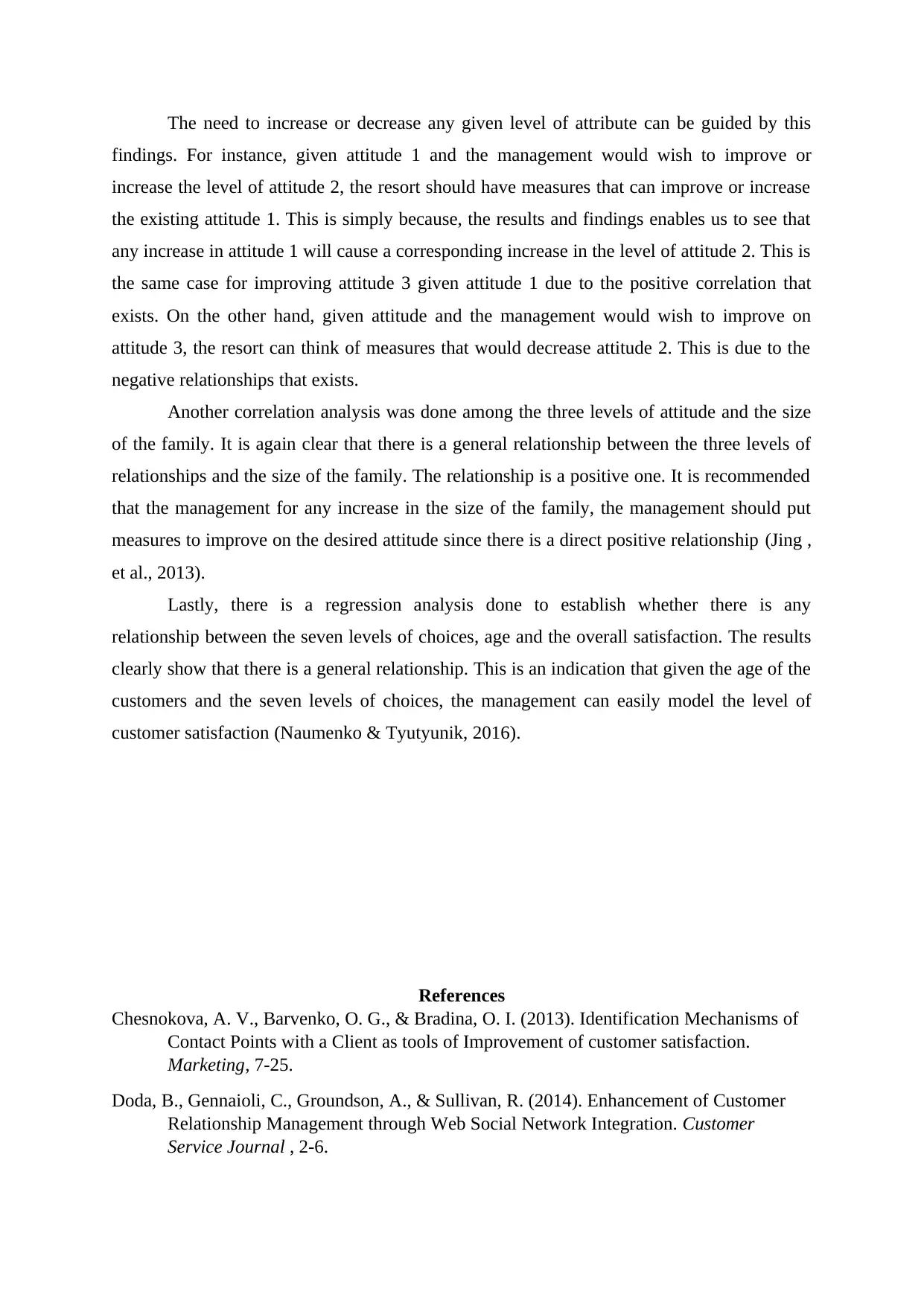
The need to increase or decrease any given level of attribute can be guided by this
findings. For instance, given attitude 1 and the management would wish to improve or
increase the level of attitude 2, the resort should have measures that can improve or increase
the existing attitude 1. This is simply because, the results and findings enables us to see that
any increase in attitude 1 will cause a corresponding increase in the level of attitude 2. This is
the same case for improving attitude 3 given attitude 1 due to the positive correlation that
exists. On the other hand, given attitude and the management would wish to improve on
attitude 3, the resort can think of measures that would decrease attitude 2. This is due to the
negative relationships that exists.
Another correlation analysis was done among the three levels of attitude and the size
of the family. It is again clear that there is a general relationship between the three levels of
relationships and the size of the family. The relationship is a positive one. It is recommended
that the management for any increase in the size of the family, the management should put
measures to improve on the desired attitude since there is a direct positive relationship (Jing ,
et al., 2013).
Lastly, there is a regression analysis done to establish whether there is any
relationship between the seven levels of choices, age and the overall satisfaction. The results
clearly show that there is a general relationship. This is an indication that given the age of the
customers and the seven levels of choices, the management can easily model the level of
customer satisfaction (Naumenko & Tyutyunik, 2016).
References
Chesnokova, A. V., Barvenko, O. G., & Bradina, O. I. (2013). Identification Mechanisms of
Contact Points with a Client as tools of Improvement of customer satisfaction.
Marketing, 7-25.
Doda, B., Gennaioli, C., Groundson, A., & Sullivan, R. (2014). Enhancement of Customer
Relationship Management through Web Social Network Integration. Customer
Service Journal , 2-6.
findings. For instance, given attitude 1 and the management would wish to improve or
increase the level of attitude 2, the resort should have measures that can improve or increase
the existing attitude 1. This is simply because, the results and findings enables us to see that
any increase in attitude 1 will cause a corresponding increase in the level of attitude 2. This is
the same case for improving attitude 3 given attitude 1 due to the positive correlation that
exists. On the other hand, given attitude and the management would wish to improve on
attitude 3, the resort can think of measures that would decrease attitude 2. This is due to the
negative relationships that exists.
Another correlation analysis was done among the three levels of attitude and the size
of the family. It is again clear that there is a general relationship between the three levels of
relationships and the size of the family. The relationship is a positive one. It is recommended
that the management for any increase in the size of the family, the management should put
measures to improve on the desired attitude since there is a direct positive relationship (Jing ,
et al., 2013).
Lastly, there is a regression analysis done to establish whether there is any
relationship between the seven levels of choices, age and the overall satisfaction. The results
clearly show that there is a general relationship. This is an indication that given the age of the
customers and the seven levels of choices, the management can easily model the level of
customer satisfaction (Naumenko & Tyutyunik, 2016).
References
Chesnokova, A. V., Barvenko, O. G., & Bradina, O. I. (2013). Identification Mechanisms of
Contact Points with a Client as tools of Improvement of customer satisfaction.
Marketing, 7-25.
Doda, B., Gennaioli, C., Groundson, A., & Sullivan, R. (2014). Enhancement of Customer
Relationship Management through Web Social Network Integration. Customer
Service Journal , 2-6.

Frankfort-Nachias, C. &.-G. (2015). Social Statistics for a diverse society. Thousand Oaks,
CA: Sage Publications.
Jackson, S. M. (2017, November 24). Methods . Retrieved from Writing@CSU Colorado
State University Department of English: http://writing.colostate.edu/research/stats/
Jing , W., Michael, S., Scott, C., Hanxi, Z., Gregor, V., & Bill, S. (2013). Customer-managed
end-to-end lightpath provisioning. Part 15, 7-9.
Kapustina, L. M., & Babenkova, A. V. (2010). Assessment of Business Customers
Satisfaction With the Product and Service of Pnevmostroimashina, JSC, on the B2B
Market. Marketing, 2-4.
Lee, Eun, Y., Park, & Chan, S. (March, 2014). Does advertising exposure prior to customer
satisfaction survey enhance customer satisfaction ratings? Marketing Letters, 11.
Lind, D. A. (2008). Statistical Techniques in Business & . Boston.: McGraw-Hill Irwin.
Miles, & Samantha. (2011). Stakeholder Definitions: Profusion and Confusion. EIASM 1st
interdisciplinary conference on stakeholder, resources and value creation, IESE
Business School. Barcelorna.
Naumenko, M. O., & Tyutyunik, A. M. (2016). Ways to provide quality customer Service in
the business of restuarant management . Customer Relationships Journal, 2.
S, H. H. (2008). Developing an index for online customer satisfaction: Adaptation of
American Customer Satisfaction Index. Marketing Letters, 10.
Shestakov, A. L., Sidorov, A. I., Shefer, L. A., & Gichkina, E. V. (2010). A quality
management system for an institution of higher education: analysis of customer
satisfaction.
Stuart A., O. K. (2009). Kendall’s Advanced Theory of Statistics: Volume 2A- Classical
Inference & the linear Model.
Verhoef, P. C., Reinartz, W. J., & Krafft, M. (2010). Customer Engagement as a New
Perspective in Customer Management. Journal of service, part 13, 2-4.
CA: Sage Publications.
Jackson, S. M. (2017, November 24). Methods . Retrieved from Writing@CSU Colorado
State University Department of English: http://writing.colostate.edu/research/stats/
Jing , W., Michael, S., Scott, C., Hanxi, Z., Gregor, V., & Bill, S. (2013). Customer-managed
end-to-end lightpath provisioning. Part 15, 7-9.
Kapustina, L. M., & Babenkova, A. V. (2010). Assessment of Business Customers
Satisfaction With the Product and Service of Pnevmostroimashina, JSC, on the B2B
Market. Marketing, 2-4.
Lee, Eun, Y., Park, & Chan, S. (March, 2014). Does advertising exposure prior to customer
satisfaction survey enhance customer satisfaction ratings? Marketing Letters, 11.
Lind, D. A. (2008). Statistical Techniques in Business & . Boston.: McGraw-Hill Irwin.
Miles, & Samantha. (2011). Stakeholder Definitions: Profusion and Confusion. EIASM 1st
interdisciplinary conference on stakeholder, resources and value creation, IESE
Business School. Barcelorna.
Naumenko, M. O., & Tyutyunik, A. M. (2016). Ways to provide quality customer Service in
the business of restuarant management . Customer Relationships Journal, 2.
S, H. H. (2008). Developing an index for online customer satisfaction: Adaptation of
American Customer Satisfaction Index. Marketing Letters, 10.
Shestakov, A. L., Sidorov, A. I., Shefer, L. A., & Gichkina, E. V. (2010). A quality
management system for an institution of higher education: analysis of customer
satisfaction.
Stuart A., O. K. (2009). Kendall’s Advanced Theory of Statistics: Volume 2A- Classical
Inference & the linear Model.
Verhoef, P. C., Reinartz, W. J., & Krafft, M. (2010). Customer Engagement as a New
Perspective in Customer Management. Journal of service, part 13, 2-4.
1 out of 13
Your All-in-One AI-Powered Toolkit for Academic Success.
+13062052269
info@desklib.com
Available 24*7 on WhatsApp / Email
![[object Object]](/_next/static/media/star-bottom.7253800d.svg)
Unlock your academic potential
© 2024 | Zucol Services PVT LTD | All rights reserved.